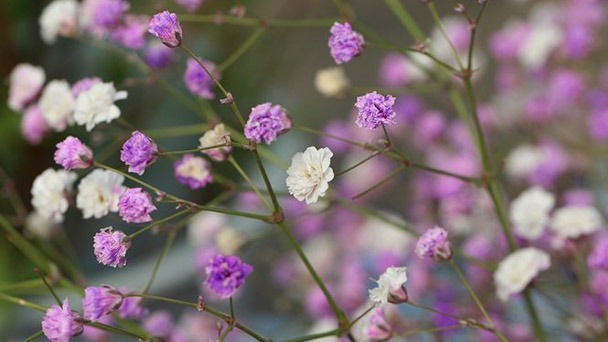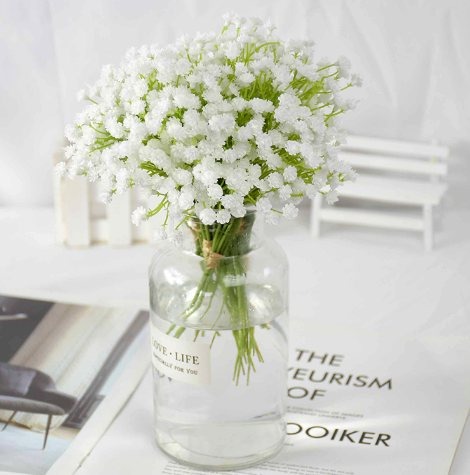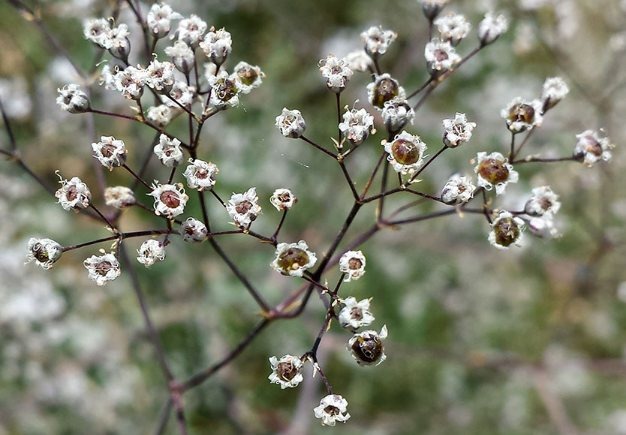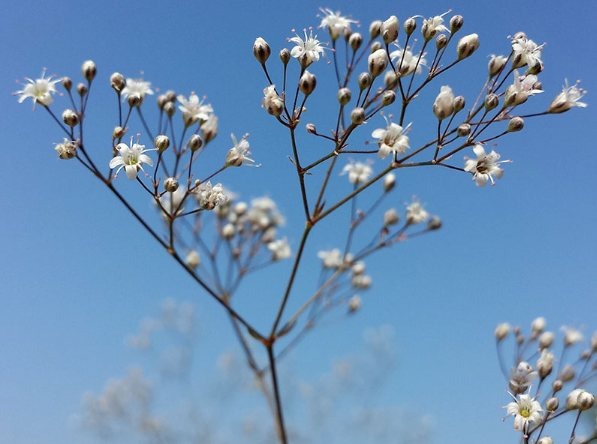How to Grow & Care for Unicorn Gypsophila
Written by Ivy
Jan 06 2023

Unicorn Gypsophila is a plant that produces vivid and attractive flowers; the plant is also known as "baby's breath." They can reach a height of two and a half feet and have up to ten branches that bear flower clusters. It's readily dyeable and available in a variety of colors.
Is Gypsophila the Same as Baby's Breath?
Gypsophila is the botanical name for the plant commonly known as "baby's breath."
Since they are frequently used for romantic engagements, these flowers have significant romantic value and are therefore primarily associated with weddings.
What is Unicorn Gypsophila?
Baby's breath (scientific names Gypsophila paniculata and Gypsophila elegans) is a small, white flower most commonly known for being a filler in cut flower arrangements, especially ones featuring roses. The flower is a member of the carnation family of herbaceous plants, Caryophyllaceae. Each baby's breath plant can produce hundreds of blooms, despite the fact that its blooms are only about the size of a pencil eraser. This makes them a magnificent addition to a flower garden. Since the summer and fall-blooming baby's breath flowers will conceal the perennials at the end of their blooming season, many gardeners prefer to plant baby's breath around spring-blooming perennials.

When to Plant Unicorn Gypsophila
Just after your region's last frost date in late spring or early summer, plant Unicorn Gypsophila (whether from seeds, cuttings, or established plants). You only need to plant baby's breath once to enjoy the flowers in your garden each year because it is a perennial plant in the majority of the United States.
Due to its hardiness, rapid spread, and ability to outcompete other plants for nutrients, Unicorn Gypsophila is regarded as an invasive wildflower or noxious weed in several US states. For information on whether planting Unicorn Gypsophila is permitted where you live, consult the laws of your state.
How to Plant Unicorn Gypsophila from Seeds
Purchasing Unicorn Gypsophila seeds is one way to grow the plant in your garden. The hardy perennial can flower after a full year, despite the ease of planting seeds. To grow Unicorn Gypsophila from seeds:
- Choose the site. Unicorn Gypsophila prefers full sun, so make sure to choose a location where it will receive at least six hours of direct sunlight each day.
- Prepare the soil. The best conditions for growing Unicorn Gypsophila are well-draining, slightly sandy, organically rich soil. The pH of the soil should be between 7.0 and 7.5 for the plant to thrive.
- Sow the seeds. Sprinkle seeds across the flower bed to sow them. Either lightly cover the seeds with soil with a sprinkle, or gently press the soil down to bury the seeds.
- Water. As your seeds grow and germinate, keep the soil moist.
- Thin the seedlings. Use garden shears to thin your seedlings back to a distance of 12 inches apart once they are one to two inches tall in order to avoid competition.
How to Plant Unicorn Gypsophila from Cuttings
Cuttings from mature bushes can be used to start Unicorn Gypsophila plants. To grow Unicorn Gypsophila from cuttings:
- Choose the right containers. Plants from stem cuttings should first be started indoors before being moved outside because this is the most reliable method. Pick out a container (or a few) with drainage holes to start.
- Prepare the soil. The ideal soil conditions for growing Unicorn Gypsophila are well-draining, slightly sandy, rich in organic matter, and between 7.0 and 7.5 on the pH scale.
- Select the stems. Cut stems that are three to five inches long from an established Unicorn Gypsophila plant.
- Prepare the stems for planting. Each stem's bottom third should be leafless. Although this step is optional, it will yield the quickest results if you apply rooting hormone to the bottom of each stem to promote root growth.
- Plant the cuttings. Each cutting should be planted by burying the lower inch of the stem in potting soil.
- Keep moist. Keep the soil evenly moist while the new plants are establishing themselves and growing roots.
- Transplant to the flower bed. Your cuttings ought to have roots by the end of four weeks. Transplant each cutting into the garden, selecting and preparing a location that receives at least six hours per day of direct sunlight. Allow each plant one foot of space on each side for growth.
How to Plant Unicorn Gypsophila from Established Plants
If you don't want to plant Unicorn Gypsophila from seeds or stem cuttings, you can grow an established Unicorn Gypsophila plant in your garden:
- Choose the site. Choose a location that receives at least six hours of direct sunlight each day because Unicorn Gypsophila prefers full sun.
- Prepare the soil. Unicorn Gypsophila thrives in well-draining soil that is slightly sandy, rich in organic matter, and has a pH between 7.0 and 7.5.
- Plant the Unicorn Gypsophila. Place the sprouted Unicorn Gypsophila plant in a hole that is only slightly wider and deeper than its root ball. Fill in the empty space after that to keep the plant stable.
- Stake the plant, if necessary. Insert a stake beside the plant and secure it gently if the stems are having trouble staying upright.
- Water. After planting, lightly water the area to encourage soil settling.
- Take cuttings. You can propagate your Unicorn Gypsophila plant by taking cuttings from the flower and planting them in various locations around your garden once it has developed roots.
How to Grow and Care for Unicorn Gypsophila
Once your Unicorn Gypsophila is in the ground, it only requires basic maintenance to thrive:
- Water. It can withstand periods of dry soil once it has established itself. Your Unicorn Gypsophila is drought-tolerant. Every week or so, give your baby's breath a light misting of water by moistening the soil; monitor the plants to determine the ideal watering cycle for your region. Install a drip irrigation system or water only the base of your plants if they are suffering from a fungal infection to avoid wetting the flowers and branches.
- Stake. Unicorn Gypsophila plants can get up to four feet tall, so they might need staking to get started. Put a thin stake (like bamboo) close to the roots of your baby's breath bushes if you notice them leaning to one side. Then, tie the plant to the stakes with a loop or two of twine.
- Prune. Unicorn Gypsophila plants don't need deadheading, which is the practice of removing spent flowers to make room for new growth, but your Unicorn Gypsophila bushes may require pruning to make the white flowers stand out the best among your other garden plants. To keep the bush in the desired shape, simply prune back stray branches.
- Overwinter. Cut back your perennial Unicorn Gypsophila after the last bloom and cover it with mulch to protect it from the winter elements if you experience particularly cold or wet winters.
Things to Take Care of When Looking After Gypsophila

For a plant to flourish, its keeper must provide care. All plants are delicate, as was already mentioned, and with great care, they can provide a lot for you and your garden. The same is true of Gypsophila; despite not needing as much attention as other plants, they still contribute significantly by blooming for extended periods of time and giving your garden an airy appearance. However, there are a few things that should not be forgotten when caring for Gypsophila. We've compiled a list of considerations for growing gypsophila or Unicorn Gypsophila in your garden.
1. Sunlight
Unicorn Gypsophila needs 6-7 hours of sunlight each day, and when it gets enough of it, it grows a lot. This plant develops quickly in the sun and consistently blooms for 6-7 weeks. Therefore, keep your plant in a location that receives enough sunlight for it to grow briskly.
2. Water
How much water your Gypsophila plant receives is one of the most important factors to pay close attention to. Unicorn Gypsophila doesn't need a lot of water, and the soil shouldn't ever be left muddy or overwatered around it. Every two to three days, give it a light watering and keep it slightly dry.
3. Protection from Insects
Baby's breath rarely gets insects or mold, but it's better to be safe than sorry and take precautions than to expose your plant to pests. As the plant needs room to avoid insects or mold that can spread, keep it away from other plants.
Unicorn Gypsophila Appearance
Baby's breath, also known as the unicorn gypsophila, is a distinctively shaped flower with numerous branches emerging from the main stalk.
Each branch is covered in scores of tiny flower clusters and dozens of small lance-shaped leaves.
White, pink, yellow, indigo, and blue are just a few of the color options for the plant.
Most frequently, they are cut fresh and made into bouquets. Both bouquets that contain only baby's breath and bouquets with multiple flowers look great when using them.
The "Unicorn" name is given to baby's breath bouquets that have been dyed in a variety of bright pastel colors.
Is Unicorn Baby's Breath Dyed?
While dyeing unicorn baby breath is an option, it's not required. A lot of the time Unicorn baby's breath is simply several colors of Gypsophila mixed into a single bouquet.
Having said that, some florists and hobbyists enjoy dying unicorn baby's breath to make it even more colorful and eye-catching.
If the baby's breath is dyed, it might also have additional vibrant colors, glitter, or even ribbons or streamers affixed to the stems.
Unicorn Gypsophila Vs. Rainbow Gypsophila
Other than glitter, ribbons, and (in many cases) a little spray paint, there aren't many differences between Unicorn and Rainbow Gypsophila.
Unicorn Gypsophila is a vibrant Baby's Breath bouquet with some glitter and pastel paints added to the flowers to make them pop.
While Unicorn Baby's Breath bouquets often have additional embellishments (such as ribbons and glitter), Rainbow Gypsophila typically has even more vivid, bold colors.
Is Gypsophila Perennial?
Gypsophila is indeed a perennial plant. It comes from Europe and is a member of the Caryophyllaceae (carnation) plant family.
Each winter, the plant goes dormant; the following spring, it starts to grow; and in the summer and fall, it blooms famously.
How Long Does Baby's Breath Flowers Last?
When whole and attached to the plant, Gypsophila flowers bloom for a month, but when they are cut, they stop blooming. When it comes to durability, Baby's breath cut flowers are impressive because they last for approximately 14 days. Many flowers don't survive that long after being cut.
Is Gypsophila Easy to Grow?
Gypsophila is one of the easiest perennial flowers to grow. They take little time to start and are simple to grow in a variety of climates.
Once established, they essentially continue to grow on their own with little need for maintenance like fertilizing and pruning.
Is Gypsophila Poisonous?
Unfortunately, Gypsophila is actually poisonous. It is not fatal, which is a good thing.
Skin and eye irritations as well as asthma and sinus issues are common symptoms of Gypsophila poisoning.
Because of this, you should always use caution when handling or growling baby's breath, such as by wearing gloves every time.
Does Baby's Breath Help Fight Cancer?
Another benefit of this widely used ornamental plant is that it may be able to fight cancer. The flowers of Unicorn Gypsophila have a chemical inside of them called " Saponins" which breaks down cancer cells. According to a few studies, this plant can be very effective in fighting cancer. Always wear gloves when handling saponins, even though the chemical found inside its flowers has the ability to fight cancer. It is reported that a small number of people have experienced allergic reactions after touching the chemical.

Is Unicorn Gypsophila Edible?
Unicorn Gypsophila is toxic to humans and should not be consumed. Most people experience vomiting, diarrhea, excessive sweating, nervousness, and tremors after eating the plant.
Unicorn Gypsophila Colors
In addition to the additional splashes of color found in dyed bouquets, gypsophila, also known as baby's breath, is available in a wide array of colors today.
The most common Unicorn Gypsophila colors include:
- White
- Pink
- Yellow
- Indigo
- Blue
- Brown
- Orange
- Green
- Purple
It is significant to note that there are numerous hybrid varieties of Unicorn Gypsophila available in additional colors due to its popularity.
Can You Grow Unicorn Gypsophila in Pots?
Unicorn Gypsophila grows in pots just as well as any other plant does. Because Unicorn Gypsophila plants are so aggressive, it is actually strongly advised to grow them in containers rather than in the ground.
If planted in your flower beds or gardens, Gypsophila are likely to be incredibly invasive. Just make sure the pots are placed in an area that receives at least 6 hours per day of direct sunlight.
Types of Unicorn Gypsophila
The number of endemic species and varieties of Unicorn Gypsophila is about thirty. The most popular varieties include:
- Bristol Fairy. It can reach a height of 4 feet and is one of the common white varieties of Unicorn Gypsophila.
- Million Star. Perhaps the most famous of all Gypsophila, this one produces white and pinkish flowers and reaches over 2 feet tall on average.
- Pink Fairy. Those who enjoy pink flowers particularly favor this variety. It grows rapidly and reaches a maximum height of only 1 1/2 feet.
- Compacta Plena. This variety, a smaller one with tiny white and pink flowers, reaches heights of 1 1/2 to 2 feet.
- Perfecta. This variety bears white, medium-sized flowers that can reach heights of up to 3 feet.
- Viette's Dwarf. It is yet another wonderful variety that grows tiny pink flowers and only grows to a height of 1 foot.
- Queen Anne's Lace. As one of the most popular varieties of Unicorn Gypsophila, Queen Anne's Lace can reach heights of 1 to 4 feet and bears white flowers in clusters that resemble white embroidered lace.
- Festival Star. One of the tiniest baby's breath varieties, these plants have white flowers and grow to a maximum height of 1 to 1 1/2 feet.
- various kinds of Gypsophila. The wild perennial variety Annual Baby's Breath, Orlaya, Funtime, Overtime, and numerous hybrids are other noteworthy baby's breath cultivars.
How to Dye Unicorn Gypsophila
Dying Unicorn Gypsophila is a fun and rewarding activity (not to mention a profitable one) for those who enjoy floral decorations.
Dying them is simple:
- Prepare a place for them to dry after they've been dyed (cardboard or wax paper is excellent)
- Separate your flowers into separate but tight groupings (tie a string or rubber band around their stems to make sure they stay together)
- Don't be afraid to get them wet! Dip or spray each group in the color of your choice.)
- Set each group onto the surface you prepared for them to dry on (set them down on their side)
Consider including ribbons, glitter, sprinkles, and/or sparkles in the mix if you want to get fancy.
Gypsophila Vase Life
The expected vase life of Gypsophila is around one week (give or take a day or two). Naturally, there are ways to prolong their life after being cut, but only for a short while.
When cutting your Gypsophila for the vase, use a sharp instrument so you get a clean cut. Additionally, remember to change the water in the vase every day, and think about adding a small amount of nutrients.
Conclusion
One of the most vibrant and unusual types of baby's breath is unicorn gypsophila. Regardless of whether they have been dried, dyed, sparkled, or are simply growing organically, they are unquestionably a fan favorite for a very good reason: they look amazing.
Latest Updated
- Benefits of Bugleweed - 7 Science-backed Health Benefits
- Bugleweed Dangers & Side Effects - Is It Poisonous?
- How to Plant Evergreen Trees - What You Should Know
- When to Plant Evergreens - Grow Guide for Evergreen Trees
- 12 Wonderful Evergreen Shrubs for Your Garden
- 12 Popular Evergreen Plants with Pictures for Beginners
- When And How To Prune A Lilac Bush Like a Pro
- How to Grow & Care for Lilac Vine (Hardenbergia Violacea)
- Japanese Lilac Tree (Syringa Reticulata) Care & Propagation Guide
- Shumard Oak Pros and Cons - What to Know
Popular Articles
- Winter maintenance of Antirrhinum Majus
- How to Grow Terminalia Mantaly Tree
- How to Grow and Care for Crossostephium Chinense
- How to grow Antirrhinum Majus in spring
- Peristeria Elata (Dove Orchid) Profile: Info & Care Guide
- Underwatered Snake Plant (Sansevieria Trifasciata) - Signs And How To Fix
- How to Care for Brazilian Jasmine Plant (Mandevilla Sanderi)
- How to Grow & Care for Graptopetalum Purple Delight in Summer
- Rosa Chinensis (China Rose): Plant Growing & Care Tips
- How to Care for Baby Sun Rose (Aptenia Cordifolia)